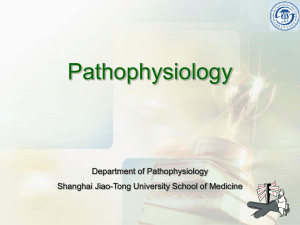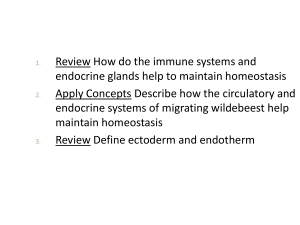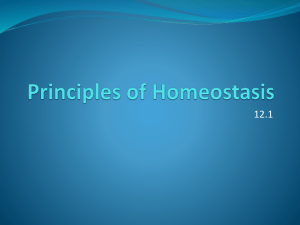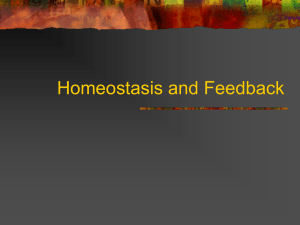(3) Outcome of disease
advertisement
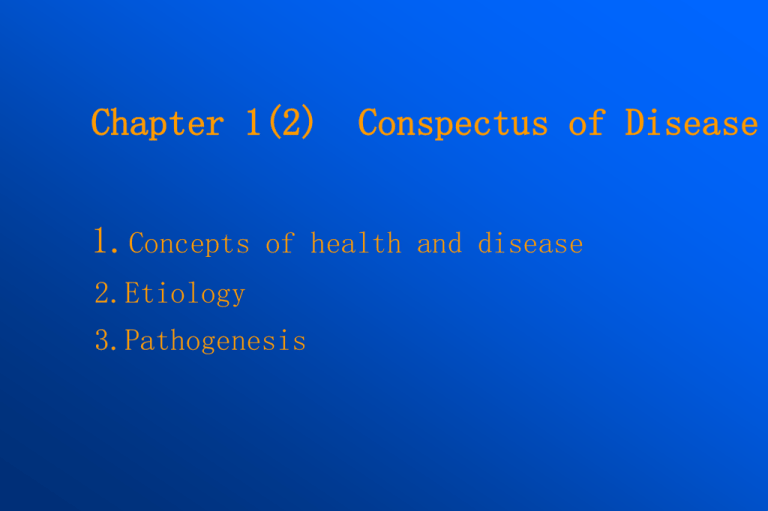
Chapter 1(2) Conspectus of Disease 1.Concepts of health and disease 2.Etiology 3.Pathogenesis 1. Concepts of health and disease (1)The definition of health from WHO: health indicates not only without any evidence of disease, but also a state of complete well-being physically, mentally and socially. Biomedical model→Bio-psycho-social medical model (2)Senescence: (3)Sub-health/chronic fatigue syndrome (CFS): a situation, in which the person does not show specific symptoms and signs of disease, but lives a low-quality of life both physically and mentally. (4)Disease: An abnormal life process which is induced by disorders of homeostasis under the action of certain causes and conditions. A pathologic process with disturbances of function, metabolism, and structure in the body, which are manifested by a characteristic set of signs and symptoms. 2. Etiology Etiology studies the contributing factors that cause diseases including causative, predisposing, and precipitating factors. (1)Etiological factors / Causes of diseases (2)Conditions for / Precipitating factors of disease (3) Predisposing factors of disease (1)Etiological factors /Causes of diseases ①A etiological factor causes a disease and determines its characteristics. ② Classification of etiological factors •Biological factors •Physical factors •Chemical factors •Nutritional factors •Immunological factors •Hereditary factors •Congenital factors •Social and psychological factors Biological factors Biological agents: microorganisms (such as bacteria, virus, fungi, rickettsia, spirochete, etc.), parasites, and their toxins and metabolic products. Physical factors Physical agents include mechanical injuries, extremes of temperature, electricity and radiation. Chemical factors Chemical agents: can damage cells by varies pathways. For instance, corrosive chemicals, such as strong acids and alkalis, can destroy cells at the site of contact. Other chemicals are selective in their sites of action, such as binding of carbon monoxide to hemoglobin. Nutritional imbalance Either excesses or deficiencies of nutrients predispose cells to injury. For example, high lipids and carbohydrates diet predispose a person to obese disease, atherosclerosis and diabetes. The most common nutritional deficiency is the lack in certain constituents, such as vitamins, calcium, and trace elements. Immunological factors Although the immune response is a normal protective mechanism, it may cause diseases when the response is •inappropriately strong (allergy or hypersensitivity) misdirected (autoimmune disease) deficient (immunodeficiency disease) Genetic factors Genetic aberrancies may be caused by single or polygenic mutations. they are transmitted by defective genes, such as sickle cell anemia, and colorblindness. •Gene mutation •Chromosomal aberration Congenital factors The disorders result from abnormal embryonic development, and most of them are nongenetic. For example, congenital birth defects, mental or physical, may be due to a developmental error during pregnancy. The fetus is usually susceptible to not only infectious diseases but also diet and drug-taking of the mother during intrauterine life; Social and psychological factors Strong or persistent psychological stimulation or stress may lead to mental illness and may be related to some diseases, such as hypertension, peptic ulcer, coronary heart disease, and depression. (2) Conditions for disease Precipitating factor: intensify the effects of causative factors and promote the onset and development of diseases, including natural, physical, and social conditions. Risk factor (3) Predisposing factors of disease •A predisposing factor refers to the factor that influences the susceptibility or resistance to certain disease. It includes the genetic constitution, physiological make up, as well as various psychological characteristics. •Genetic predisposition Summary •Specific causes and predisposing factors together determines the disease occurrence; precipitating factors influence the onset and development of illness. •Some diseases only have one cause. However, many diseases are multifactorial in origin, such as hypertension, atherosclerosis and diabetes, etc Environmental and genetic factors 3. Pathogenesis The general rules and common mechanisms underlying the development of diseases (1) The basic mechanisms of disease (2) General rules of disease development (3)Outcome of disease (1) The basic mechanisms of disease Although various specific mechanisms may underlie different disorders,they all generally involve the following four levels of deregulations: neural, humoral, cellular and molecular mechanisms. Neural mechanism •Neural system plays a central role in regulating entire life activities; the disturbance occurred in neural system and in periphery organs are mutually affected. •Encephalitis B virus can damage neural system directly; some poisons may interrupt the metabolism of neural cells and the production and release of neurotransmitters. Humoral mechanism (humoral factors, cytokines) Humoral regulation is crucial in maintaining internal homeostasis. Humoral dysfunction generally indicates the alterations in number and in activities of some humoral factors( hormones, chemical mediators, cytokines). They function through endocrine, paracrine, and autocrine to regulate the metabolism and activities of the cells . During the development of diseases, the regulations in humoral and neural system are usually simultaneous e.g. disturbance of neural-humoral regulation in hypertension: constant stress--- dysfunction of neural system (cerebral cortex and hypothalamus)--- sympathetic-adrenal medulla system----increased secretion of norepinephrine and epinephrine--- constriction of arteries/ constriction of renal afferent arterioles will activate rennin-angiotensinaldosterone system, and finally causes hypertension. Cellular and molecular mechanism Cellular and molecular damages or alterations are fundamental in the development of disease. Strong acid and alkali destroy the cells with no selection; hepatitis virus damages specifically the hepatocytes. •Disease genomics: Disease proteomics Integrated medicine, Systems biology 整体水平 器官水平 细胞水平 分子水平 研究疾病 时功能代谢结 构的变化及其 发生机制 (2) General rules of disease development The general rules for a disease to take place and develop •Disruption of homeostasis by pathological insults •Body’s responses to damages and anti-damage activities •Reversal role of cause-consequence in the disease process •Relationship between systemic and local alterations Regulation and disruption of homeostasis •Homeostasis: the process whereby the internal environment of an organism tends to remain balanced and stable, which is required for optimum functioning. e.g., maintenance of temperature homeostasis. •Disruption of homeostasis by harmful agents may cause diseases. e.g., hyperthermia Responses of damages and anti-damages •Damages induce anti-damage responses, and the interactions go through the whole process of diseases and determines the development of diseases •Overdo of anti-damages cause new injures e.g. Burning injury (damage)-- constriction of small blood vessels: maintaining proper blood pressure (anti-damage). However, sustained vasoconstriction--hypoxia, cellular necrosis, and dysfunction. Alternation of cause and result in disease process •A cause of a disease leads to a result, which can be a new cause for another results in the development of the disease, even forming vicious cycle, e.g. hemorrhagic shock. 机械力 创伤大失血 心输出量↓ 交感-肾上腺系统兴奋 心率↑ 血管收缩 细胞缺氧 心收缩力↑ 良 性 循 环 微循环障碍 维持动脉血压 休克 恢复 死亡 大失血时的因果交替示意图 恶 性 循 环 Correlation between systemic and local regulations Local alterations and the systemic statues can affect each other and disease development. e.g., a severe furuncle will not only cause local inflammation, but also lead to systemic reactions of fever and elevated leukocytes. On the other hand, a furuncle may be caused by diabetes and could only be cured by proper control of diabetes. (3) Outcome of disease ----complete recovery, incomplete recovery, death The outcome of a disease is determined by the fight between the evil forces and the defending forces, correct diagnosis and treatment. Complete recovery The best outcome of a disease: •the etiological factors disappear •the pathologically altered metabolism, structure and function are perfectly restored •the symptoms and signs of the disease disappear entirely • homeostasis is recovered Incomplete recovery The main symptoms and signs disappear but some pathological changes are left behind, namely sequela. Sequela is generally brought about by the compensatory response to maintain a relatively normal activity. For example, the permanent damage to the heart valve after rheumatic fever. Death agonal stage stage of clinical death stage of biological death Brain death Brain death is a state of prolonged irreversible cessation of all brain activity with the complete absence of conscious and voluntary movements, responses to stimuli, brain stem reflexes, and spontaneous respirations. Criteria for brain death (WHO) •Irreversible coma cerebral unresponsibility •Cessation of spontaneous respiration •Absence of cephalic reflexes and dilated pupils •Absence of electrical activity of brain •Cessation of cerebral circulation Precise diagnosis of brain death is important for having proper donors in organic transplantation. Brain death (脑死亡) 定义 自主呼吸 意识 脑干反射 恢复的可能性 全脑功能丧失 无 丧失 无 无 Vegetative state(植物状态) 脑的认知功能丧失 有 有睡眠—醒觉周期,但无意识 有 有 Summary •Research (Molecular, genetic, comprehensive, multidiscipline) •Purpose: mechanisms, prevention, diagnosis, and treatment •Disease spectrum changes


